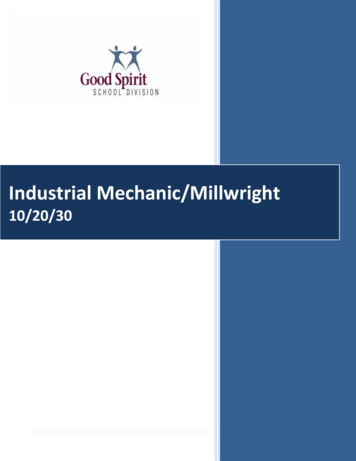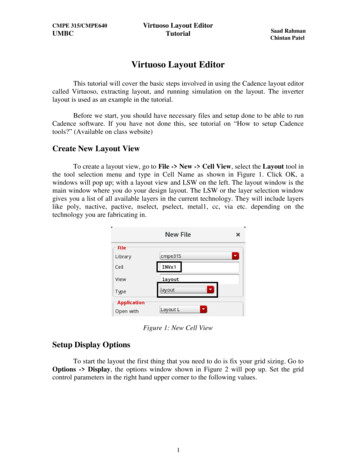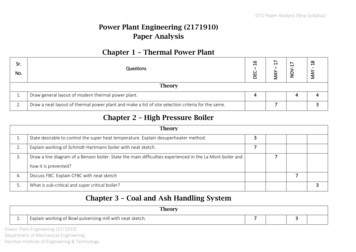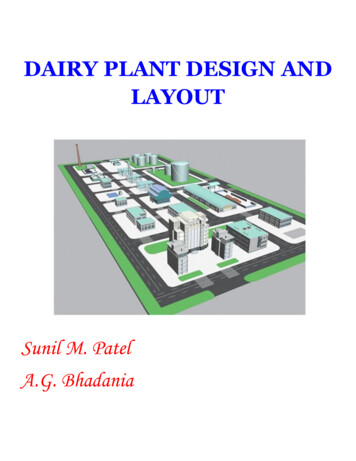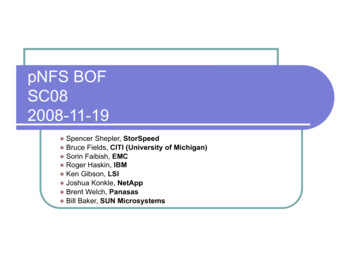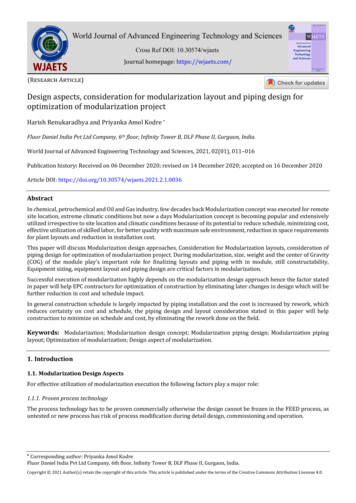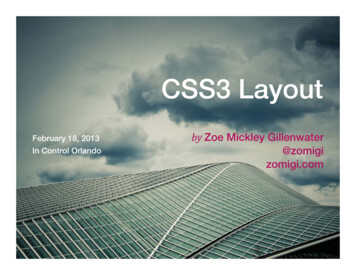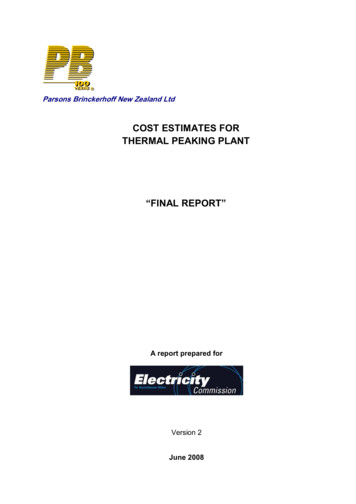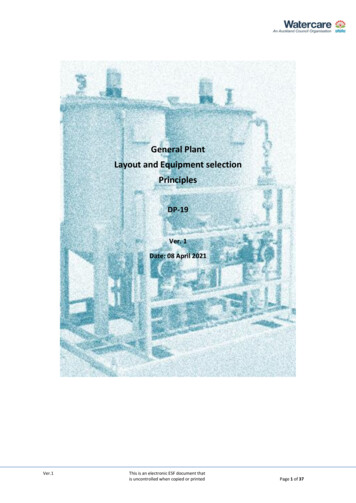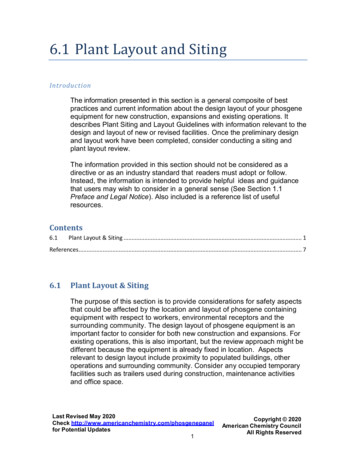
Transcription
6.1 Plant Layout and SitingIntroductionThe information presented in this section is a general composite of bestpractices and current information about the design layout of your phosgeneequipment for new construction, expansions and existing operations. Itdescribes Plant Siting and Layout Guidelines with information relevant to thedesign and layout of new or revised facilities. Once the preliminary designand layout work have been completed, consider conducting a siting andplant layout review.The information provided in this section should not be considered as adirective or as an industry standard that readers must adopt or follow.Instead, the information is intended to provide helpful ideas and guidancethat users may wish to consider in a general sense (See Section 1.1Preface and Legal Notice). Also included is a reference list of usefulresources.Contents6.1Plant Layout & Siting . 1References . 76.1Plant Layout & SitingThe purpose of this section is to provide considerations for safety aspectsthat could be affected by the location and layout of phosgene containingequipment with respect to workers, environmental receptors and thesurrounding community. The design layout of phosgene equipment is animportant factor to consider for both new construction and expansions. Forexisting operations, this is also important, but the review approach might bedifferent because the equipment is already fixed in location. Aspectsrelevant to design layout include proximity to populated buildings, otheroperations and surrounding community. Consider any occupied temporaryfacilities such as trailers used during construction, maintenance activitiesand office space.Last Revised May 2020Check http://www.americanchemistry.com/phosgenepanelfor Potential Updates1Copyright 2020American Chemistry CouncilAll Rights Reserved
There are published technical materials and guidance books that specificallyaddress Facility Siting and Building Siting. Some of these include: Guidelines for Facility Siting, CCPS Guidelines for Evaluating Process Plant Buildings for ExternalExplosions, Fires and Toxic Releases, CCPS Management of Hazards Associated with the Location of ProcessPlant Portable Buildings, API 753 Management of Hazards Associated with the Location of ProcessPlant Permanent Buildings, API 752The guidance discussed in this section is not meant to replace thesereference books or similar reference books, but to provide additionalconsiderations for the siting of phosgene containing equipment.“Siting” means conducting a review of the location of equipment andpiping with regard to: 1) possible impact on human or environmentalreceptors, or 2) where other plant operations could have impact on thephosgene equipment. In case one, for example, design layout mightconsider such items as predominant wind direction and populated areasdown wind. In case two, the considerations might include items such asany flammable or potential explosive processes, which - if an eventoccurred - could have impact on the phosgene equipment.The following section on Plant Siting and Layout Guidelines providesinformation relevant to the design and layout of new or revised facilities. Itis important to note that the following criteria represent considerations oftenused by facilities handling hazardous materials. However, given the highlytoxic nature of phosgene, during the construction of new phosgenehandling facilities, or significant modifications to existing facilities, facilitiesshould also consider what secondary mitigation measures may also benecessary or appropriate to address the potential risk to local populationsresulting from significant loss of containment.Items to consider may include:A)Plant Siting Locating phosgene containing units with consideration ofprevailing wind direction as far as possible from thegeneral community outside the site boundaries.Last Revised May 2020Check http://www.americanchemistry.com/phosgenepanelfor Potential Updates2Copyright 2020American Chemistry CouncilAll Rights Reserved
B) Protecting on-site buildings occupied by a large numberof people through a combination of engineering controls,administrative procedures and/or distance, togetherwithin a site to minimize the spread of phosgenecontaining areas. Conducting a facility siting risk assessment regardinglocation of phosgene facilities within a site Locating phosgene containing units away from otherprocesses which have potential for explosion or fire, orevents which may impact or damage equipmentcontaining phosgene. Incorporating additional safety and loss preventionprecautions if phosgene must be transported acrossplant boundaries either by pipeline or in pressurizedcontainers.Plant Layout Providing that all sections of the plant are easily accessiblefor maintenance and emergency response purposes. Locating phosgene generating or processing sections inplant areas with low traffic density whenever possible andminimizing phosgene containing pipelines. Having additional engineering controls for prevention andmitigation of leaks from the equipment where plant sectionshave special process conditions, or where because of thesurrounding situation, other controls may be needed. Thereare several other parts of Section 6 that provide guidancefor such controls including materials of construction,secondary containment, and spill mitigation. Refer to thoseparts for additional information. Designs that incorporate“layers of protection” rather than relying on a single methodof control are relevant in this capacity.Last Revised May 2020Check http://www.americanchemistry.com/phosgenepanelfor Potential Updates3Copyright 2020American Chemistry CouncilAll Rights Reserved
C) Selecting the location of the control building in relation tothe phosgene containing sections and with consideration ofthe prevailing wind direction. Wherever the selectedlocation, having an elevated fresh air intake in the controlbuilding and maintaining the building under positivepressure have been used to minimize infiltration ofphosgene in the event of a release. Ensuring that temporary facilities (such as trailers) usedduring construction, maintenance contractors or officespace for plant support personnel are located withconsideration to the hazards of phosgene. Emergencyprocedures should include the occupants of thesetemporary facilities.Design Final ReviewOnce the preliminary design and layout work have been completed,consideration should be given to conducting a siting and plantprocess or a simple review using a series of questions or checklists.There are a number of published approaches available. Some ofthese include: Center For Chemical Process Safety Dow FEI and CEIGuidelines; Center For Chemical Process Safety Book on Guidelines forSafe Storage and Handling of Highly Toxic HazardousMaterials; and US EPA Risk Management Planning, Section 112 regulationsand application guidelines.Other considerations such as pressurized control buildings, shelter inplace locations (safe havens), phosgene leak detectors and alarms,explosion resistant windows and walls can also be relevant.In addition to the plant siting and layout options noted above, thefollowing are some possible questions that can be used in facility sitingreviews. The questions can be applied to both existing plants and newplants.1. For facilities in the United States, has a phosgene releasebeen addressed as part of the US EPA’s RMP Plan WorstCase and Alternate Case Scenarios?Last Revised May 2020Check http://www.americanchemistry.com/phosgenepanelfor Potential Updates4Copyright 2020American Chemistry CouncilAll Rights Reserved
2. Do you have local plot plans?3. Do you have local maps showing potential offsite exposure /receptor sites?4. Do you have historical meteorological data, wind rose andstability classes?5. Has the maximum release quantity of phosgene beenidentified?6. Are there occupied buildings or occupied temporary trailers inor near (e.g., within 100 meters) the possible phosgenerelease or storage points?7. Are there roadways (public or private), bridges or tunnelsnear the possible phosgene release or storage points?8. Is there some other public transportation (e.g., railways, marine,aviation) near possible phosgene release or storage points?9. Has access for maintenance equipment (e.g., cranes, forklifts,and cherry-picker devices) been addressed in the design of thephosgene storage and handling areas?10. Has the design addressed multiple and reliable emergencyescape routes for egress? Have these routes considered anytemporary occupied trailer facilities?11. Is the phosgene storage vessel potentially exposed to acredible external fire scenario?12. Is there a need for, or consideration of, a formal API RP 752a. Facility Siting Study or Screening Study? Wereappropriate standards used to determine layout andspacing of the phosgene facilities?13. Is there a need to examine the discharge orientation ofphosgene safety relief devices (e.g., pressure safety valves;vent scrubber discharges)?14. Are there any building air intakes positioned such that theycould induce phosgene vapors?Last Revised May 2020Check http://www.americanchemistry.com/phosgenepanelfor Potential Updates5Copyright 2020American Chemistry CouncilAll Rights Reserved
15. Are any buildings intended to be designated as temporaryshelter in place locations (safe havens), and if so, what criteriaare used (pressurized, double airlocks, etc.)?16. Can phosgene migrate through underground sewers/ orclosed drain systems?17. Have you identified and evaluated every “low” point (e.g., sump,manhole, or other place) where phosgene vapor could collect?18. Has the electrical area classification been considered?19. Has the drainage and run-off from deluge systems andunusual intensive rain been considered? Has pooling incurbed or diked areas also been considered?20. Has the location of the control room and operator shelter,and degree of building airtight integrity been considered?21. Are there overhead power lines?22. Have you considered a controlled access area in or near thephosgene facilities and the distance (degree of separation) fromuncontrolled access areas that are used by other nonphosgene unit personnel?23. Have you considered suitable distance between thephosgene facilities and the plant boundary property line(fence line)?24. Is the property adequately fenced to prohibit access by thegeneral public?25. Is the phosgene facility enclosed or open-structureconstruction? Will a small leak be able to dissipate or will it becontained in a building?26. Is there emergency lighting for egress in the event of apower failure?27. Is there an emergency alarm system for phosgene releases?28. Have the consequences of site-specific hazards such asearthquake, hurricanes, lightning, and floods been evaluated?Last Revised May 2020Check http://www.americanchemistry.com/phosgenepanelfor Potential Updates6Copyright 2020American Chemistry CouncilAll Rights Reserved
29. Is there a detection system within buildings or the fresh air intakesystem to detect toxic material?30. Is automatic or manual shutdown of fresh air intake systems intooccupied buildings necessary?ReferencesGuidelines for Facility Siting, CCPShttp://www.wiley.comGuidelines for Evaluating Process Plant Buildings for External Explosions, Firesand Toxic Releases, CCPShttp://www.wiley.comManagement of Hazards Associated with the Location of Process Plant PortableBuildings, API 753http://www.api.orgManagement of Hazards Associated with the Location of Process Plant PermanentBuildings, API 752http://www.api.orgDow's Fire & Explosion Index Hazard Classification Guide, 7th Edition,June h-editionCenter For Chemical Process Safety Book on Guidelines for Safe Storage andHandling of Highly Toxic Hazardous Materials by Richard LeVine, Aurthur D.Little Inc. 1988Refer to http://onlinelibrary.wiley.com for Center for Chemical Process Safetyof the American Institute of Chemical EngineersUS EPA Risk Management Planning, Section 112 regulations and es/content/rmp/index.htmLast Revised May 2020Check http://www.americanchemistry.com/phosgenepanelfor Potential Updates7Copyright 2020American Chemistry CouncilAll Rights Reserved
6.1 Plant Layout and Siting . Introduction. The information presented in this section is a general composite of best practices and current information about the design layout of your phosgene equipment for new construction, expansions and existing operations. It describes Plant Siting and Layout Guidelines with information relevant to the
